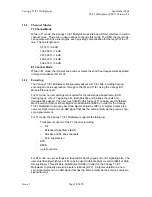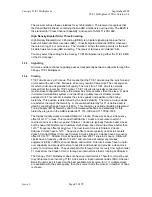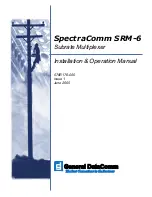
Canopy
T1/E1
Multiplexer
September
2004
T1/E1
Multiplexer
FPGA
Version
3.4
Page
20 of 73
For E1 mode, the Canopy T1/E1 Multiplexer supports the following:
◦
Transparent support of the E1 channel
◦
AMI
◦
HDB3
◦
up to three ports
Alternate Mark Inversion (AMI)
The template of the DS-1 signal is bipolar. This means that a plus voltage, a zero voltage,
and a minus voltage are important to the coding of the signal. The code that is used in T1
is called Alternate Mark Inversion (AMI). The requirement is that if a “1” (or Mark) is
coded as a positive voltage, the very next “1” must be coded as a minus voltage or the
result will be a bipolar violation (BPV). Another one of the requirements of the coding
sequence is that a “1” bit is sent to maintain the timing synchronization. A signal that is
sending all “0s” would be a constant zero voltage line. The eventual result would be that
the system’s timing would be lost. In order to overcome the potential situation where a
string of “0s” causes a loss of the system’s timing, a number of zero suppression
techniques have been designed. Common techniques are used to handle zero
suppression requirements are:
◦
1 in 15 Requirement
◦
B8ZS.
◦
HDB3
The Canopy T1/E1 Multiplexer fulfills the role of a transparent T1/E1 extender. As such, it
is compatible with either AMI, B8ZS, or HDB3 coding of signals. The endpoints determine
which of the zero suppression techniques will be applied to the signal. The Canopy T1/E1
Multiplexer must be set to match the zero suppression settings at the endpoints of the
signal.
The 1 in 15 Requirement (AMI)
The 1 in 15 requirement stipulates that no more than 15 “0s” may be sent be for every “1”
that is transmitted. The easiest approach is to make every bit 8 a “1” and to use only the
lower 7 bits for data transmission. This 7/8 mode yields a rate of 56 kbps instead of the
standard DS-0 rate of 64 kbps. This technique also prevents the use of signaling bits
since bit 8 is now used for a different purpose.
Configuring the Canopy T1/E1 Multiplexer to AMI accommodates the stipulations for bit
handling identified in the 1 in 15 requirement.
Binary Eight Zero Substitution Coding
The limitations imposed by the 1 in 15 requirement led to the development of Binary Eight
Zero Substitution (B8ZS) coding. This signal coding technique takes advantage of BPVs
in the data stream to be decoded as signal. With B8ZS coding, each block of eight
consecutive zeros is replaced with the B8ZS code word. The transmitted bit stream will
contain two AMI violations.
Issue
3
















































